人教版高中英语 必修一 Unit4 《Earthquake---Warming up &Reading》 课件 (共40张PPT)
- 格式:ppt
- 大小:3.27 MB
- 文档页数:11
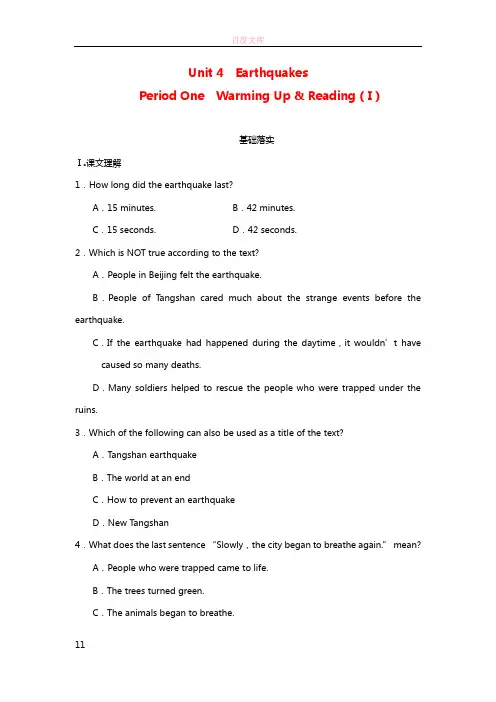
Unit 4 EarthquakesPeriod One Warming Up & Reading (Ⅰ)基础落实Ⅰ.课文理解1.How long did the earthquake last?A.15 minutes. B.42 minutes.C.15 seconds. D.42 seconds.2.Which is NOT true according to the text?A.People in Beijing felt the earthquake.B.People of T angshan cared much about the strange events before the earthquake.C.If the earthquake had happened during the daytime,it wouldn’t have caused so many deaths.D.Many soldiers helped to rescue the people who were trapped under the ruins.3.Which of the following can also be used as a title of the text?A.Tangshan earthquakeB.The world at an endC.How to prevent an earthquakeD.New T angshan4.What does the last sentence “Slowly,the city began to breathe again.” mean?A.People who were trapped came to life.B.The trees turned green.C.The animals began to breathe.D.The city returned to normal gradually.5.Many strange things happened in the countryside EXCEPT that________.A.the well walls had deep cracks in themB.some animals were too nervous to eatC.fish jumped out of bowls and pondsD.birds flew higher than usual6.Why didn’t people lose hope after the earthquake?A.Because the army came to help them.B.Because they could help themselves.C.Because most of the 10,000 miners were rescued from the local mines.D.Because shelters were built for the survivors whose homes had been destroyed.Ⅱ.课文缩写Several days before July 28,1976,many 1.________ things happened in Tangshan.They were signs for an 2.________.But people 3.________ lived there di dn’t think much of that.At 3∶42 am that day,the earth began to shake,which 4.________ almost all the city in fifteen terrible seconds.Many people,including workers and doctors,came to 5.________ those who were 6.________ under the ter that afternoon,another big earthquake hit the city.More people were killed or 7.________ and more buildings 8.________ down.Very soon the army sent a lot of soldiers to help,and teams were 9.________ to dig out the trapped and to 10.________ the dead.By and by things improved and the city began to breathe again.Ⅲ.用适当的介、副词填空1.________ three days the water ________ the village wells rose and fell,rose and fell. 2.A smelly gas came ________ of the cracks.3.______ about 3∶00 am ______ July 28,1976,some people saw bright lights ______ the sky.4.It was felt in Beijing,which is more than two hundred kilometres ________. 5.No wind,however,could blow them ________.6.Soon after the quakes,the army sent 150,000 soldiers ___ Tangshan to help the rescue workers.7.______ the north of the city,most of the 10,000 miners were rescued ____ the coal mines there.8.Workers built shelters ________ survivors whose homes had been destroyed.Ⅳ.用课文中的词语替换划线部分1.I told him immediately what I thought of him.________________2.It sounds as_though you had a good time.________________3.I went into the old house and found Grandad’s medals.________________4.A_great_many people are fond of what they are doing.________________5.She suddenly_began_to_cry when she saw her lost son.________________6.In 15 seconds,a large city was_completely_destroyed.________________Ⅴ.句型转换1.All of them are not right.________ ________ of them are right.2.It’s eight o’clock already and now we must be off at once.It’s eight o’clock already and now we must be off ________ ________.3.It seems that Bob knows everything,but in fact,he is stupid.It seems ________ ________ Bob knew everything,but in fact,he is stupid.4.I bought a dictionary yesterday and it cost me 80 yuan.I bought a dictionary yesterday, ________ cost me 80 yuan.5.I happened to meet an old friend of mine in the street last week.________ ________ ________ I met an old friend of mine in the street last week.能力提升阅读理解When an earthquake hit a small town,many houses fell down.After the earthquake,all the newspapers reported many stories about some of the families who were in trouble.One Sunday,when I was reading a newspaper,a special picture touched me.It gave the clothing sizes of each family member.I thought that this would be a good chance to teach my children to help those who were less lucky than themselves.I said to my sevenyearold twins,Brad and Brett,and threeyearold Meghan,“We have so much,and these poor people now have nothing.We’ll share what we have with them.”I filled a box with foods and clothes.While I was doing this,I encouraged the boys to choose their toys and donate some of their less favourite things.Meghan watched quietly as the boys took out their old toys and games and put them together.Then she walked away.A few minutes later she came back with Lucy,her muchloved doll.She put the doll on top of the other toys.“Oh,dear,”I said.“You don’t have to give Lucy.You love her so much.”Meghan said,“Lucy makes me happy,Mommy.Maybe she’ll make another little girl happy, too.”I looked at Meghan for a long moment.She taught me a lesson.It’s easy to give something that we don’t want any more,but hard to give what we cherish(珍爱),isn’t it?1.The writer has ________ children.A.one B.twoC.three D.four2.The under lined word “donate” in Paragraph 3 probably means “________”.A.捐赠B.丢掉C.展出D.放好3.Which of the following is TRUE?A.An earthquake happened in the writer’s hometown.B.The writer let Meghan give her muchloved doll.C.The writer decided to buy some clothes for those people in trouble.D.The writer thinks it is more difficult to give what we love a lot. 4.What’s the best title of this passage?A.A Family Story B.The Spirit of GivingC.The Way of Helping Others D.A Sad Experience答案基础落实Ⅰ.1.C 2.B 3.A 4.D 5.D 6.AⅡ.1.strange 2.earthquake 3.who 4.destroyed 5.rescue 6.trapped 7.injured 8.fell anized 10.buryⅢ.1.For;in 2.out 3.At;on;in 4.away 5.away 6.to 7.T o;from 8.for Ⅳ.1.right away 2.as if 3.dug out 4.A great number of 5.burst into tears/burst out crying y in ruinsⅤ.1.Not;all 2.right;away 3.as;if 4.which 5.It;happened;that能力提升1.C 2.A 3.D 4.B。
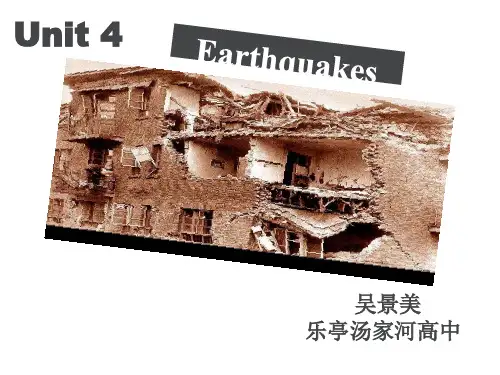
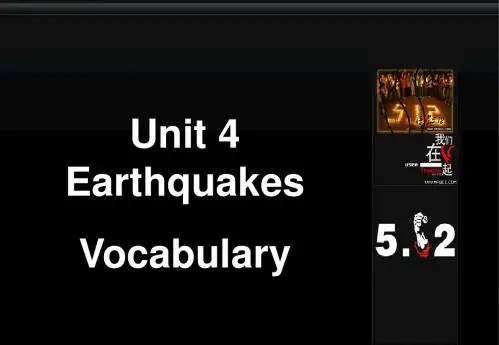
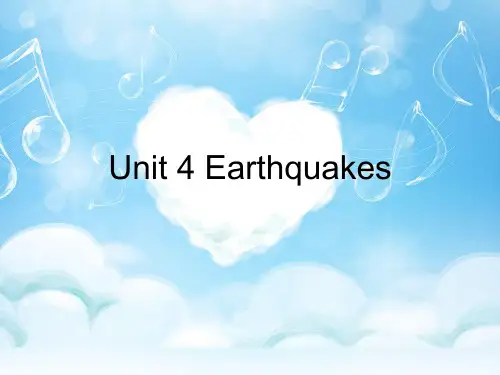

Welcome to our class!■上图:四川绵竹县汉旺镇中学内,一位被埋在废墟中的女学生伸岀一只求援的手不停地呼唤着“救救我” O孩子,别放弃希望,孩子,别哭!我们一定要把所有的障碍移开,让你重新看见蓝色的天空!在这苦难的一刻,所有的人都在伸出救助之手。
X1•J JHi卜尸5^0^ ES L jrk P上图:四川省北川县北川中学生在接受救治。
四川汶川地 震发生后,北川县北川中学 六至七层高的主教学楼塌陷 ,当时正值上课时间,21个 教室里师生约1000人,除个 在瓦砾堆中。
目前,大批武 警官兵以及当地群众正在加 紧救援。
1000人啊!用什么 能换冋他们的生命!今后, 应该规定,任何地方政府的 办公楼,不得高于学校的标 准!除了把最好、最安全的 建筑给孩子们,还能用什么 来补偿和赎罪!,一名被压在瓦砾堆中的学 别逃生以外,大部分被掩埋上图:救护人员在汉旺镇武都小学废墟上抢救幸存的小学生。
在手拉着手的那一刻,孩子,你还会无助的哭泣吗?h 满身鲜血,但挡不 '住医护人员的真挚救护之心。
后面的大哥 ,一定要抱好照顾好这位兄弟啊,你们痛苦就是我们的痛苦,党和政府没有忘记你们!只要有人在,我I们还会重建家园的。
■两个刚被救出的孩子,一个眼神很迷茫,似乎对地震还心肴奈悸 ;另一个好象已经进入了梦乡,也好象是受伤昏了过去。
他们的父母呢?是不是还没有音信?地震对孩子们的心貝创冷充夫,谁来抚平?让他们有吃的,有喝的 ,把他们首先安顿好吧!一列摆放着的地震死难者遗体。
大灾夺去了你们的生命,默哀!向你们的人送去深深的慰问和关切。
I抗震救灾众志成城\°、f(\凝粟中国的力量I?H4Natural Dlstflooddroughtistor styphoone a r t h q ua k evolcano*:〔•—•・{•「一 - . -•…七* *'■八… ••••…■•. :\ . ・.・ X*• •Tornado • •Task3o o youknowwhy: euvthquulce Aro 0<G占ppJ O J ⑴ r j (A s J (r<2.8 aFWdys on mymmdH ・美lateAntarctic plateis反African plate阳归线环:霰*愛仪 “• f . •站India plateX. (腿播/矗辟紅十J也/American plate【:$••盘 4;厂卷;八 ItfSPSSan Francisco全球岩石圈六大板块…•'岂+•■厂 J,:怦■ A 丫八 T丸・丁亚欧板®Eurasian 太平洋板 Pacificplate 汁,「;1主要山脉 八生长边界(海岭、断尉 [■消亡边界(海沟*造山带American plate B 華泸[駆SM瞬删腐為畑GE昨觀,Earthquake Happens Pacific plate53iHi •;<•賊llljiLlli也护,4・ «>.xe'd?曜:■-:曲$:sfi・-• •- '唐山.avi• 4 . 4^ * * 1j ■-・•、1 '■儿 * * JI E•*・・-・•*'What do you think may happen before an earthquake?What do you think may happen before an earthquake?rose fellcrackssmelly宀’夕T-What do you think may happenbefore an earthquake?looking forjumpedWhat do you think may happen before an earthquake?barkingbefore an earthquake?bright before an earthquake?What should we do to protect ourselves if an earthquake happened?Thank you for your attending!Wish you good luck everyday!•乞。
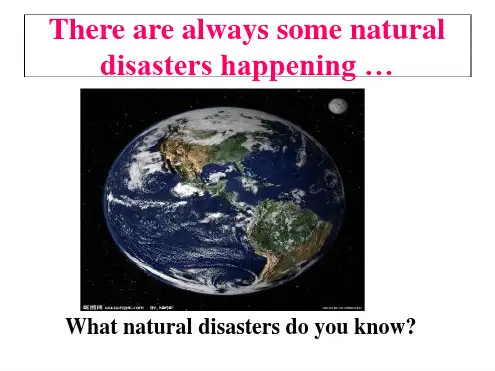
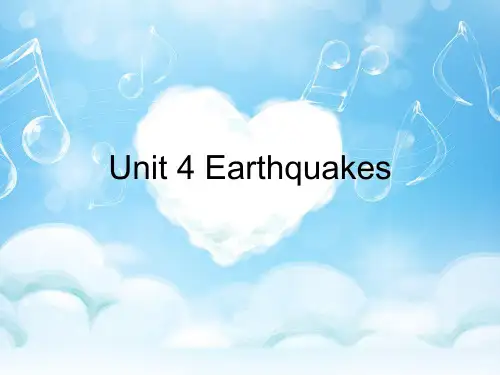
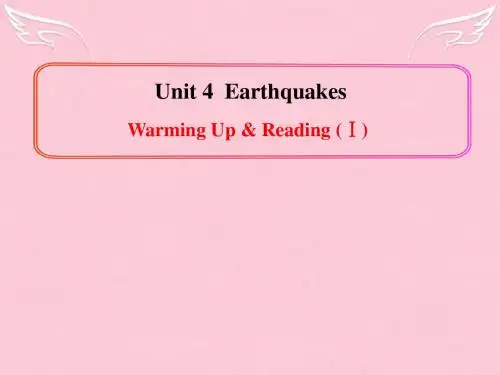
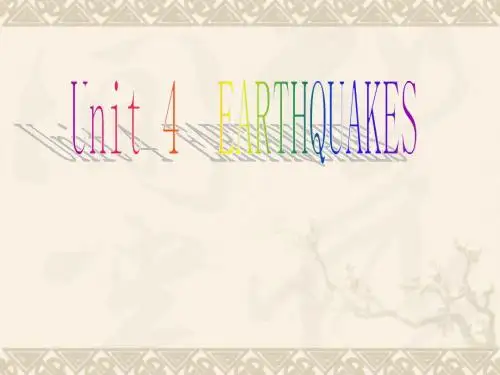
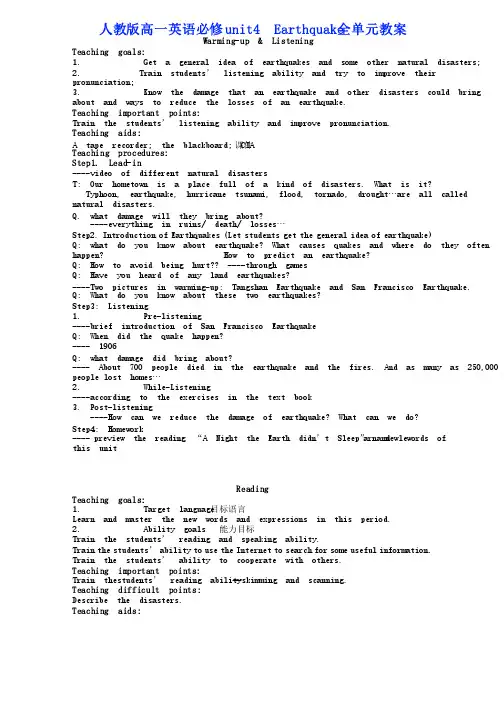
人教版高一英语必修unit4 Earthquake 全单元教案 Warming-up & Listening Teaching goals: 1. 1. Get a general idea of earthquakes and some other natural disasters;2. 2. Train students’ listening ability and try to improve their pronunciation;3. 3. Know the damage that an earthquake and other disasters could bring about and ways to reduce the losses of an earthquake.Teaching important points: Train the students’ listening ability and improve pronunciation.Teaching aids:A tape recorder; the blackboard; CIA 课件课件 Teaching procedures: Step1. Lead-in ----video of different natural disastersT: Our hometown is a place full of a kind of disasters. What is it?Typhoon, earthquake, hurricane tsunami, flood, tornado, drought…are all called natural disasters.Q. what damage will they bring about? ---- e verything in ruins/ death/ losses…everything in ruins/ death/ losses… Step2. Introduction of Earthquakes (Let students get the general idea of earthquake)Q: what do you know about earthquake? What causes quakes and where do they often happen? happen?How to predict an earthquake? Q: How to avoid being hurt?? ----through gamesQ: Have you heard of any land earthquakes?----Two pictures in warming-up: Tangshan Earthquake and San Francisco Earthquake. Q: What do you know about these two earthquakes?Step3: Listening1. 1. Pre-listening----brief introduction of San Francisco EarthquakeQ: When did the quake happen?---- 1906Q: what damage did bring about? ---- About 700 people died in the earthquake and the fires. And as many as 250,000 people lost homes…2. 2. While-Listening----according to the exercises in the text book3. Post-listening----How can we reduce the damage of earthquake? What can we do?Step4: Homework ---- preview the reading “A Night the Earth didn’t Sleep” and le arn new words of this unitReading Teaching goals: 1. 1. Target language目标语言 Learn and master the new words and expressions in this period.2. 2. Ability goals能力目标 Train the students’ reading and speaking ability.Train the students students’ ’ability to use the Internet to search for some useful information. Train the students’ ability to cooperate with others.Teaching important points: Train the s tudents’students’students’ reading ability reading ability —skimming and scanning. Teaching difficult points: Describe the disasters.Teaching aids:CIA课件课件Teaching procedures:Step1. Lead-inT: We have a visit to the museum of natural disasters, and you have learned about some brief introduction of most disasters. Today, I want to show you round the earthquake department, and I hope you will like it and learn some useful knowledge.go.let’s go.Now let’sT: At the very beginning, I want to know how much you know about an quake.Q1: What would you take with you if a quake happened?Q2: The best way to save yourself is to know there will be a quake before it happens.What kind of signs can tell you that there is a quake?Q3: What kind of damage can an earthquake cause?S: buildings are destroyed; people are killed; families are broken…have a look at some pictures of such terrible site. (Pictures of quakes) T: Let’sLet’s have a look at some pictures of such terrible site. (Pictures of quakes) T: (The last picture is monument of Tangshan quake.) Do you know what this is? Step2. Pre-Readingth, a terrible disaster suddenly happened,T: 30 years ago, on the day July, the 28and the beautiful Tangshan was removed from the map. This is Tangshan quake. Does any body know something about Tangshan quake?T: Let’s read a news report about the famous quake.Step3. While-readingI. Skimming & scaringGet the students comprehend the passage quickly and accurately, and meanwhile helpthe students to form a good habit of reading.T: First please skim the passage fast to obtain/ get a general understanding of the whole passage. And underline the answers to the following questions.II. While reading, divide the whole passage into 3parts and find out the main ideaof each part.Para.1 before the quakePara.2-3 during the quakePara.4 after the quakeII. Careful-readingRead the passage again and try to get more detailed information.againn and find more information. Join the correct partsT: Now let’s read the passage agaiof the sentences. (Turn to page 27, ex1)T: Now you have read the passage carefully, please put the sentences in order. Numbereach of these things during the Tangshan quake.(Turn to page 27, ex2)T: here are some more work for you. You can work in groups.T: Let’s watch some pictures, and comparing the old Tangshan, the Tangshan after quake, and the new Tangshan we see today.Step 4 Post-reading (discussing)T: After read the news report, and see so many pictures, what impresses you most? Why?Or what do you learn from such a disaster?)(Self-rescue, environment protection, rebuilt, love and helpI: self-rescue (a video game)T: When in a quake, if you know some self-rescue skills, you may probably save yourself.If you want to know some of the skills, click here. (Link to the index)-rescue.Let’s do little game to see how much you know about selfII. What did they suffer and feel?T: Can you understand what they suffer and what they feel after such a disaster? T: If you were one of the rescuers 30 years ago, what could you say and what can y do to comfort them? Or how could you help them?III. RebuildingT: we see that the new Tangshan has been set up. What is needed to rebuild Tangshan.IV: environment protectionT: nowadays there are more disasters than before. One of the reasons is that we pay more attention to our economy development than the earth we live.Look at these pictures. What can we students do to save the earth?T: Though the di sasters destroy buildings, people’s lives, but it can not destroy the love among us. Step 5 Homework1. 1. Find more news reports about earthquake.2. 2. Write a piece of news about Tangshan. You can use the information in the passage.News Writing Teaching aims: 1. 1. Get students to learn how to write news;2. 2. Trainstudents the ability to cooperate with each other and to search for information;3. 3. Learnmore about Tangshan earthquake and honor the people of Tangshan. Teaching difficulties: 1. 1. How to make students learn writing in a more practical and effective way;2. 2. How to help students understand the tips for writing.Teaching procedure: Step 1: Lead-in----The 30th anniversary of Tangshan earthquake (news)T: We have learnt the Tangshan earthquake. When did it happen? How many people died during the earthquake?Step 2: Presentation of students’ news writing(homework of last class)----point out the mistakes in news writing according to three aspectsT: You have finish ed the news writing of Tangshan earthquake, and now it’s time for you to show your project. Others have to point out the mistakes in his or her writingaccording to three aspects.----Three aspects: headline; content and languageT: What do you think of his or her writing? Is it a proper news writing? What hav T: What do you think of his or her writing? Is it a proper news writing? What have you done before your writing?Step 3: Tips for writing1. 1. Preparation ---- an outlinePreparation: Choose a topic; decide what you want to say about the topic; Organize your ideas and write clearly.Outline: A headline; a list of main ideas; A list of important details2. 2. Headline⑴ Appreciation of headlines⑵ characteristics of headlinesQ: what’s the characteristic of headlines?⑶ practice ---- write headlines---- write headlines for the following news according to the picture and information givenFlood relief efforts ----The death toll on the Chinese mainland from Typhoon Kaemihas risen to 32, with at least 65 still missing. Local governments are sparing no efforts to carry out relief work.PLA celebrates 79th birthday----The Chinese People's Liberation Army is 79 years old, and the Defense Ministry has held a reception to celebrate. New business regulations;New tax on housing sales A Night the Earth didn’t Sleep; Cyclists Ready to Go on the Road for Blind Kids; China Marks 30th Anniversary of Tangshan Earthquake; Does Beijing snack change its flavor?Memories of quake die hard for Tangshan survivors; Chao Chien-ming released.Quake hits Indonesian island----A moderate earthquake has struck near Indonesia'sNias island off northern Sumatra. The quake, with a magnitude of 5.6 struck just before8.30 am, and was centered under the Indian Ocean, about 55 kilometers northwest of the main town on the island, Gunung Sitoli.Railway's impact on Tibetans----The Railway brings the remote Qinghai-Tibet plateau closer to the rest of the world. With people able to move in and out of th region more easily and the economic benefits the railway brings, the lives of Tibetanswill never be the same again.3. Content---- How to organize your content of news⑴ Tips ----Be clear of the content you want to mention; List your ideas; Write the ----Be clear of the content you want to mention; List your ideas; Write the most important thing in the beginning and the less ones in the following⑵ Practice ----write the beginning of news according to the information and picture ----write the beginning of news according to the information and picture givenA woman;rifts on the wall;earthquake measuring 5.1degrees;Wen'an County, north China'sHebeiProvince;11:56 a.m. Tuesday, July 4, 2006;the quake’s epicenter --about 110kilometers from Beijing and 80 kilometers from Tianjin;casualty –not knownA woman points at the rifts on the wall of a village school after an earthquakemeasuring 5.1 degrees on the Richter scale jolted Wen'an County, north China'sHebeiProvince at 11:56 a.m. (Beijing Time) Tuesday, July 4, 2006. The quake was a shallow-focus one, with its epicenter being around 110 kilometers from Beijing and about 80 kilometers from Tianjin. No casualty was reported at press time.4. LanguageTips----clear; ob j ective; brief; accurate; written English…jective; brief; accurate; written English… Step 4: Appreciation of newsRadio----V OA news: “VOA news: “A id Aid for tsunami victims ” News report----“Tangshan Quake 30th Anniversary ” Step 5: Improvement of students’ writing----Improve your news writing about Tangshan earthquakeUsing Language----Reading, writing and speakingTeaching Aims:1. 1. Enable the students to make a speech2. 2. Let the students enjoy some famous speechesTeaching Important and Difficult Points:1. 1. Review something about disasters2. 2. How to make a speechTeaching Methods:1. 1. Individual work2. 2. group workTeaching Aids: Computer, blackboard Teaching Procedures:Step 1 Lead-in(Teacher shows a series of pictures of some disasters on the screen, let the studentstalk about their feelings or anything they feel about the pictures.)(The pictures are: fire, hurricane, typhoon, tsunami, earthquake…)T: In this unit, we learn a lot about disasters. We know disaster is not a good thingto us. We often feel sad or sorry if a disaster happens.T: Right now, you have just seen some of the disasters. Do you feel worried about these refugees?Ss: Yes.Step 2 Discussion T: Yes, everybody will feel sorry for them. But who is the most worried people when a disaster happens?Ss: families and friends / government and president / ……..……..T: Suppose, there is an earthquake happen somewhere in China, and you have a friend happens to be there. You are very worried. What will you do when you hear that an earthquake happens there? (Let the students discuss with their partner)Ss: I will feel very worried. I will make sure my friend is Ok as soon as possible.I will make a call to see if he is Ok.T: Again, suppose you are a president of a country, and an earthquake happens in yourcountry. What will you do?Ss: It is my duty to comfort the refugees and the society. So first I will mak a live speech to the whole country, telling my people that I know it and I will tr my best to organize the rescue work and the rebuilding work after the earthquake. T: Yes, you are very clever. In fact, a real president will do just as you said -----to make a speech. Now just let’s listen to a real speech made by President Bush aftera big earthquake hit India on the first day of New Year.(Play the tape record for the students)Step 3 Speech T: Right now we’ve just listened to a speech made by President Bush. Do you know something about how to make a speech? Can you tell me when should we make a speech? Ss: a speech competition / election / the beginning of a new year / the opening of some activity / anniversary…..T: Yes, people need to make speeches at those times. Then do you know how to make a speech? What should we contain when we make a speech?Ss: Introduction: Give a strong first impression & preview your speechBody: Explain your ideas and support themConclusion: Review your speech and leave a lasting final impression.Step 4 TextT: It seems that you know a lot about making a speech. I remember we say that we m need to make a speech when it is some important anniversary.T: You know 2006 is the 30th anniversary of Tang Shan Earthquake. Here is an invitation,inviting you to make a speech about it. You can look at the letter on your text book. T: You can include these points in your speech;1. 1. thank Mr Zhang Sha and the city government for inviting you to speak2. 2. thank the visitors, especially the survivors3. 3. thank those who worked hard to save survivors4. 4. list some of the things the workers did to help the survivors5. 5. thank those who worked hard to build the city6. 6.describe your feeling about the city, which is known as the “BraveCity of China”.7. 7. encourage the people to be always proud of their city.8. 8. thank the visitors for listening to your speech.T: So try to give a speech, using these points. Now I will give you 5miniutes to finishthe speech.(after 5 minutes)Step 5 Speech contestT: Times up. Have you finished your speech? Ok, I think it is time for us to hold a speech contest. We have 4 groups in our class. Each group, please choose one contestant to represent your group and join the class speech contest. …, …and … will be the judges.(Ask each group to give a speech and the chosen judges will choose the winner.) T: Congratulations to the winner!Step 6 ConclusionT: In this lesson we learned a lot about speech and we also made a speech by ourselves.So do you know how to make a speech now?T: At the end of the class, let’s enjoy a very famous speech in human history.(Abraham Lincoln Gettysburg Address)六.评估与反馈六.评估与反馈--------according to the “Summing Up” in unit 4according to the “Summing Up” in unit 4。
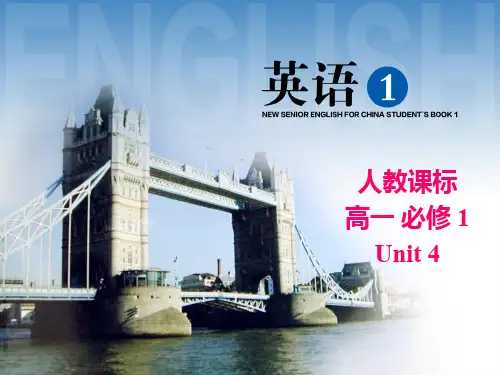
人教版高中英语必修1Unit4 Earthquake 说课稿一、教材的地位和作用本单元的中心话题是“地震” 。
本课的内容主要涉及了1976 唐山大地震的震前预兆、地震发生时的情况、震后的破坏和伤亡情况以及震后的救援工作。
对于地震,学生应该不陌生,有相应的知识构架,特别是在汶川和玉树地震后,人们对地震还心存余悸,所以本课在自然知识的讲解方面应该不会有太大困难。
本文重点在于培养学生语言知识能力之外,也要鼓励学生遇到困难时勇于面对,树立“一方有难,八方支援” 的社会责任感。
二.学情分析高中一年级的学生已经在初中阶段的英语学中,已经积累了一定的词汇基础,并掌握了一些简单的学习策略和技巧,具有初步的英语听说读写能力。
但是,学生个性和英语水平差异大,因此教学设计要有梯度,由浅入深,注意层次性。
英语作为一门语言,其最基本的作用就是人际交流。
但是中国学生普遍的情况是不愿开口说英语。
因此我在课堂要鼓励学生们利用每个机会开口说英语,以达到锻炼口语的目的。
三、教学目标根据《教学大纲》的要求和学生已有的知识基础和认知能力,在仔细学习和分析教材的基础上,我确定了以下教学目标。
语言知识语言技能掌握本课的生词和一些有用的表达方法以及定语从句用法;了解与地震有关的知识。
根据已知信息推测将要学习的材料;(推测)能运用所学语言知识描述地震前兆、危害及震后援救;(说)学习阅读中略读和找读,和细读的技能(读)学习唐山人民勇敢面对自然灾害的精神;在教学活动中培养学生的合作精神和互助精神。
了解世界各地的自然灾害和大地震的情况, 了解有关地震的知识,启发学生国际援助意识。
培养学生通过各种渠道如报纸、杂志、图书馆和网络等资源搜集信息的能力。
情感态度文化意识学习策略四.教学重点和难点 1.重点:培养学生在阅读过程中获取和处理信息的能力。
2.难点:学生利用所学知识谈论地震这个话题。
五.教学方法与工具。
根据高中生的心理特点,宜采用形式多样的教学方法和学生积极主动参与的学习方式,激发学生的学习兴趣,让他们在学习中学会参与,在参与中学会学习。
Unit 4EarthquakesPeriod 1Warming up and ReadingKnowledge aims:1. Get the students to learn the following useful new words and expressions in this passage:shake well (n. )rise crack smelly pond pipe burst canal steam dirtruin injure destroy brick dam useless steel shock quake rescue electricitydisaster army organize bury coal mine shelter fresh right away at an end lie in ruins be trapped under sth. a (great)number of2. Get the students to know basic knowledge about natural disasters.Ability aims:1. Develop the students reading ability and let them learn different reading skills.2. Train the students’ ability to collect useful information from the Internet by themselves.Emotional aim:1. Get the students know damages earthquakes bring about and the ways to reduce losses of earthquakes.2. Get the students to know how to protect oneself and help others in earthquakes.3. Get the students to be aware of terrible disasters, meanwhile get them to face it, treat it in a proper way, and never get discouraged.教学重点1. Get the students to know basic knowledge about natural disasters.2. Get the students to learn about Tangshan Earthquake.3. Get the students to learn different reading skills.教学难点Develop the students’ reading ability.教学方法1. Task-based teaching and learning2. Cooperative learning3. Discussion教具准备The multimedia and other normal teaching tools教学过程→Step 1 Lead-inShow the students some pictures about natural disasters and ask them:1. Have you ever experienced any natural disaster? Look at the pictures. Can you name all the disasters?(volcano, fire, typhoon, flood, sandstorm, hailstone, thunderstorm, hurricane, earthquake)2. Have you ever experienced an earthquake? Can you describe how terrible an earthquake is?地震的破坏(The earth is shaking; all the buildings will fall down; the roads will be destroyed; many people will be killed or injured; a lot of children will become orphans. . . )→Step 2 Warming upTurn to Page 25. Ask the students to read and look at the photos of Tangshan and San Francisco to describe what they see in the two photos to a partner.(beautiful cities; broad roads; tall building; large population. . . )Imagine there has been a big earthquake in these two cities, what might happen to all the things in the photos?(If a big earthquake happened, the whole cities might be in ruins. Large quantities of tall buildings might collapse. The broad and busy roads might be destroyed. Many people might be killed or injured. . . )→Step 3 Pre-reading1. Imaging and sharingImagine there is an earthquake now. Your home begins to shake and you must leave it right away. You have time to take only one thing. What will you take? Is it money, water, fruits, mobile phones, a torch light, or anything else? Why?2. Talking and sharingWhat do you think may happen before an earthquake? Talk about the pictures on Page 25.(Cows, pigs and dogs become too nervous to eat. Mice run out of the fields looking for places to hide. Fish jump out of ponds. The water in the well will rise and fall. The well walls will have deep cracks in them. There will be bright light in the sky. . . )→Step 4 ReadingTell the students:Today, we are going to read a news report about the strongest earthquake in China’s history, which happened in Tangshan, Hebei, in 1976.1. Fast readingAsk the students to read the passage quickly and pay attention to the first sentence of each paragraph.1)Answer the questions.Question 1:In what order was the passage written?Question 2:What is the general idea of the passage?(The text is written in time order. The general idea is the mixture of the first sentences of each paragraph, that is, the text tells us something that happened before the earthquake, during the earthquake and after the earthquake. )2)Fill in the table.Type of writingTopic sentence of Paragraph 1Topic sentence of Paragraph 2Topic sentence of Paragraph 3Topic sentence of Paragraph 4General idea of the passageSuggested answers:Type of writing This is a news report.Topic sentence of Paragraph 1 Strange things were happening in thecountryside in northeast Hebei.Topic sentence of Paragraph 2 Everything began to shake and it seemed thatthe world was at an end.Topic sentence of Paragraph 3 Everywhere they looked nearly everything wasdestroyed.Topic sentence of Paragraph 4 All hope was not lost.General idea of the passage The passage tells us something that happenedbefore the earthquake, during the earthquakeand after the earthquake.3)True or False?Ask the students to decide whether the following statements are true or false. If it is false, try to correct it.(1)People in Tangshan were warned of the earthquake and didn’t go to bed that night.(2)People in Beijing also felt the earthquake.(3)More than 400 000 people were killed in the quake.(4)Many rescue workers and doctors were trapped under the ruins during the aftershock.(5)People tried to get fresh water from under the ground in Tangshan.Suggested answers:(1)F People in Tangshan thought little of the signs of the earthquake and went to bed as usual that night.(2)T(3)F More than 400 000 people were killed or injured in the quake.(4)T(5)F Fresh water was taken to the city Tangshan by train, truck and plane.2. Reading carefullyAsk the students to read the passage carefully to locate particular information.1)Do the exercises in the part Comprehending on Page 27.2)Fill in the following form.Time What happened ResultBefore the earthquake:three days before the earthquakeat about 3 am on July 28Wells:Animals:Lights and sound:Water pipes:People of the citythought______________and______________While the earthquake:At 3:42 amLater that afternoonHouses, roads andcanals:Hard hills of rock:The large city:The people:Some rescue workers anddoctors:More buildings:Water, food and electricity:______________ wasdestroyed.______________hospitals, 75%of______________ and 90%of______________ were gone.More than______________were killed or injured.After the earthquake All hope:The army:Workers:Fresh water:The city______________.3)Choose the best answer:(1)What is the mood of this passage?A. Sad.B. Serious.C. Serious and a bit sad.D. Calm.(2)What can be inferred from the passage?A. If mice run out of the fields looking for places to hide, there must be an earthquake.B. If some natural signs had not been ignored, all the people in Tangshan city might have had a chance to survive.C. There wouldn’t have been such a great earthquake, if people had paid enough attention to some natural signs.D. If some natural signs had not been ignored, more people might have had a chance to survive.(3)Which of the following statements can not be part of the main reasons for the heavy loss of life in Tangshan earthquake?A. The earthquake happened in the deep night and people were sleeping in bed at the verymovement.B. There weren’t enough rescue workers.C. The buildings were poorly constructed and most of them were destroyed in the earthquake.D. People were not careful enough to notice some natural signs before the earthquake.(4)How do you understand the real meaning of the idiom “It is always calm before a storm”?A. It is unusually quiet before a thunderstorm or hurricane hit.B. One should not trust situations that seem peaceful since bad things may happen.C. The weather is fine before a storm comes.D. You should stay calm before a storm.Suggested answers:(1)C(2)D(3)B(4)B3. Language problemsWhile checking the answers with the whole class, deal with any language problems that the students can’t understand.4. Reading aloudPlay the tape of the passage for the students to listen and follow. Then play the tape of Paragraph 1 of the passage once more; this time the students listen and repeat.→Step 4 GameWork in pairs. Suppose you are a newspaper reporter, and the other is a witness of the 1976 Tangshan Earthquake. Now the newspaper reporter is interviewing the witness.→Step 5 ExtensionShow the questions on the screen and have a discussion.1. From whose point of view are events described? How do you know?2. What is the mood of this passage? How is it created?3. Why do you think the writer chooses to express his feelings about the quake rather than simply report what had happened?Suggested answers:1. A writer’s who didn’t see the earthquake. He uses the third-person to describe the quake. His description is very objective. For example, in the second sentence of the third paragraph “Everywhere they looked nearly everything was destroyed. ”, the writer uses “they” instead of “we”.2. The mood is serious and a bit sad. It is created by giving details of how many people and animals were killed or injured and how many buildings were destroyed.3. Although the writer was not there, he felt sad for the people of Tangshan. He knows that giving some personal feelings will make the reading more interesting.→Step 6 Homework1. Learn the new words and expressions in this part by heart.2. Read the text again and again and write a summary of the text.。